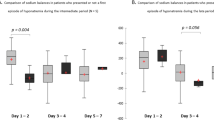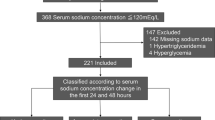Abstract
Purpose
Knowledge of the cumulative balance of sodium (CBS) is important for the diagnosis of salt disorders and water homeostasis and has the potential to predict hypovolemic status in acute neurological patients. However, an extensive application of the use of CBS is still lacking in the intensive care setting, where salt and water homeostasis represents a priority.
Methods
Records of consecutive series of acute neurological patients admitted to a neurointensive care unit over a 6-month period were retrospectively reviewed. CBS was calculated at the admission to the Emergency Department. Discrimination between cerebral salt-wasting syndrome (CSWS) and the syndrome of inappropriate antidiuretic hormone secretion (SIADH) was performed on the basis of the classical criteria. Additionally, we used the findings of a negative CBS exceeding 2 mEq/kg for the diagnosis of CSWS. Two independent clinicians who were blinded to the CBS results performed diagnosis of the causes of hyponatremia and estimated the daily volemic status of the patients on the basis of clinical parameters. Logistic regression analysis was used to determine the independent prognostic factors of hypovolemia.
Results
Thirty-five patients were studied for a total of 418 days. Four patients (11.4 %) fitted the criteria of CSWS and three patients (8.5 %) had SIADH. The unavailability of the CBS led to a wrong diagnosis in three of the eight hyponatremic patients (37.5 %). The risk of developing hypovolemia in patients with negative CBS was 7.1 times higher (CI 3.86–13.06; p < 0.001). Multivariate analysis revealed that negative cumulative fluid balance, negative CBS >2 mEq/kg, and CVP ≤5 cmH2O were independent prognostic factors for hypovolemia.
Conclusions
CBS is likely to be a useful parameter in the diagnosis of CSWS and a surrogate parameter for estimating hypovolemia in acute neurological patients.


Similar content being viewed by others
References
Tisdall M, Crocker M, Watkiss J, Smith M. Disturbances of sodium in critically ill adult neurologic patients: a clinical review. J Neurosurg Anesthesiol. 2006;18:57–63.
Diringer MN, Zazulia AR. Hyponatremia in neurologic patients: consequences and approaches to treatment. Neurologist. 2006;12:117–26.
Sherlock M, O’Sullivan E, Agha A, Behan LA, Owens D, Finucane F, Rawluk D, Tormey W, Thompson CJ. Incidence and pathophysiology of severe hyponatraemia in neurosurgical patients. Postgrad Med J. 2009;85:171–5.
Schwartz WB, Bennett W, Curelop S, Bartter FC. A syndrome of renal sodium loss and hyponatremia probably resulting from inappropriate secretion of antidiuretic hormone. Am J Med. 1957;23:529–42.
Peters JP, Welt LG, Sims EA, Orloff J, Needham J. A salt-wasting syndrome associated with cerebral disease. Trans Assoc Am Physicians. 1950;63:57–64.
Harrigan MR. Cerebral salt wasting syndrome: a review. Neurosurgery. 1996;38(152–160):23.
Hoorn EJ, Halperin ML, Zietse R. Diagnostic approach to a patient with hyponatremia: traditional versus physiology-based options. Q J Med. 2005;98:529–40.
McGee S, Abernethy WB, Simel DL. The rational clinical examination. Is this patient hypovolemic? JAMA. 1999;281:1022–9.
Shippy CR, Appel PL, Shoemaker WC. Reliability of clinical monitoring to asses blood volume in critically ill patients. Crit Care Med. 1984;12:107–12.
Jones JG, Wardrop CAJ. Measurement of blood volume in surgical and intensive care practice. Br J Anaesth. 2000;84:226–35.
Singh S, Bohn D, Carlotti AP, Cusimano M, Rutka JT, Halperin ML. Cerebral salt wasting: truths, fallacies, theories, and challenges. Crit Care Med. 2002;30(2575–2579):24.
Carlotti AP, Bohn D, Rutka JT, Singh S, Berry WA, Sharman A, Cusimano M, Halperin ML. A method to estimate urinary electrolyte excretion in patients at risk for developing cerebral salt wasting. J Neurosurg. 2001;95:420–4.
Mehta RL, Kellum JA, Shah SV, Molitoris BA, Ronco C, Warnock DG, Levin A, Acute Kidney Injury Network. Acute Kidney Injury Network: report of an initiative to improve outcomes in acute kidney injury. Crit Care. 2007;11:R31.
Levey AS, Eckardt KU, Tsukamoto Y, Levin A, Coresh J, Rossert J, De Zeeuw D, Hostetter TH, Lameire N, Eknoyan G. Definition and classification of chronic kidney disease: a position statement from Kidney Disease: Improving Global Outcomes (KDIGO). Kidney Int. 2005;67:2089–100.
The Criteria Committee of the New York Heart Association. Nomenclature and criteria for diagnosis of diseases of the heart and great vessels. 9th ed. Boston: Little, Brown & Co; 1994. p. 253–6.
Le Gall JR, Lemeshow S, Saulnier F. A new Simplified Acute Physiology Score (SAPS II) based on a European/North American multicenter study. JAMA. 1993;270:2957–63.
Stéphan F, Flahault A, Dieudonné N, Hollande J, Paillard F, Bonnet F. Clinical evaluation of circulating blood volume in critically ill patients—contribution of a clinical scoring system. Br J Anaesth. 2001;86:754–62.
Burnham KP, Anderson DR. Multimodal inference: understanding AIC and BIC in model selection. Sociol Methods Res. 2004;33:261–304.
McFadden D. Conditional logit analysis of qualitative choice behavior. In: Zarembka P, editor. Frontiers in econometrics. New York: Academic Press; 1974. p. 105–42.
R: a language and environment for statistical computing. R foundation for statistical computing, Vienna. ISBN 3-900051-07-0. http://www.R-project.org.
Sherlock M, O’Sullivan E, Agha A, Behan LA, Rawluk D, Brennan P, Tormey W, Thompson CJ. The incidence and pathophysiology of hyponatraemia after subarachnoid haemorrhage. Clin Endocrinol (Oxf). 2006;64:250–4.
Oh MS, Carroll HJ. Cerebral salt-wasting syndrome: we need better proof of its existence. Nephron. 1999;82:110–4.
Maesaka JK, Gupta S, Fishbane S. Cerebral salt-wasting syndrome: does it exist? Nephron. 1999;82:100–9.
Brimioulle S, Orellana-Jimenez C, Aminian A, Vincent JL. Hyponatremia in neurological patients: cerebral salt wasting versus inappropriate antidiuretic hormone secretion. Intensive Care Med. 2008;34(125–31):26.
Harrigan MR. Cerebral salt wasting syndrome. Crit Care Clin. 2001;17:125–38.
Wijdicks EF, Vermeulen M, ten Haaf JA, Hijdra A, Bakker WH, van Gijn J. Volume depletion and natriuresis in patients with a ruptured intracranial aneurysm. Ann Neurol. 1985;18:211–6.
Acknowledgments
We would like to thank Dr Benvenuto Antonini, from the Anesthesia and Intensive Care Department of Manerbio Hospital, Brescia. The authors wish to dedicate this work to Nicola Motterlini, outstanding researcher and statistician, gentle and brave man.
Conflict of interest
The authors have no funding or conflicts of interest to disclose.
Author information
Authors and Affiliations
Corresponding author
About this article
Cite this article
Gritti, P., Lanterna, L.A., Rotasperti, L. et al. Clinical evaluation of hyponatremia and hypovolemia in critically ill adult neurologic patients: contribution of the use of cumulative balance of sodium. J Anesth 28, 687–695 (2014). https://doi.org/10.1007/s00540-014-1814-x
Received:
Accepted:
Published:
Issue Date:
DOI: https://doi.org/10.1007/s00540-014-1814-x




